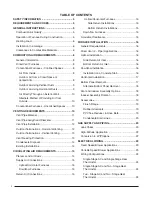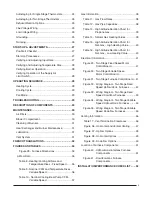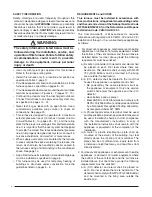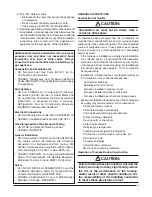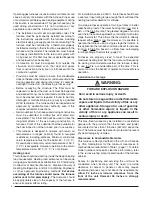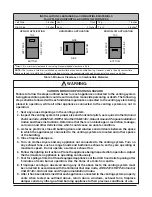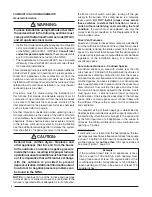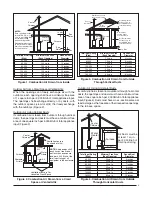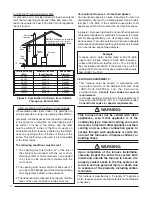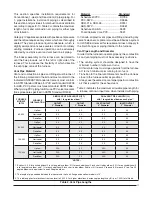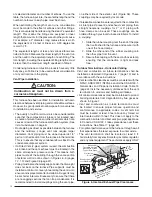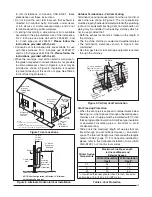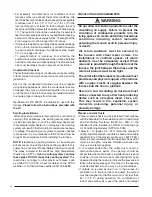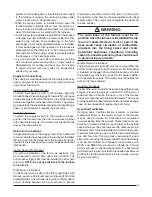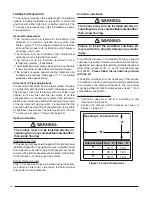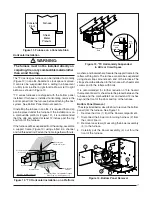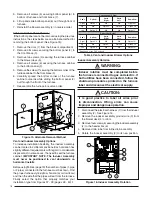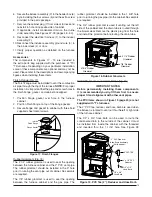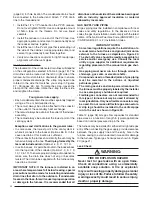
5
b.) The (CO) detector shall:
• Be located in the room that houses the appliance
or equipment;
• Be hard-wired or battery powered or both.
• Shall comply with NFPA 720 (2005 Edition).
c.) A product-approved vent terminal must be used, and
if applicable, a product-approved air intake must be
used. Installation shall be in strict compliance with the
manufacturer’s instructions. A copy of the installation
instructions shall remain with the appliance or
equipment at the completion of the installation.
Additional information listed below is for reference
purposes only and does not necessarily have
jurisdiction over local or state codes. Always
consult with local authorities before installing any
gas appliance.
Combustion and Ventilation Air
• US: National Fuel Gas Code (NFGC), Air for
Combustion and Ventilation
• CANADA: Natural Gas and Propane Installation
Codes (NSCNGPIC), Venting Systems and Air Supply
for Appliances
Duct Systems
• US and CANADA: Air Conditioning Contractors
Association (ACCA) Manual D, Sheet Metal and
Air Conditioning Contractors National Association
(SMACNA), or American Society of Heating,
Refrigeration, and Air Conditioning Engineers
(ASHRAE) Fundamentals Handbook
Electrical Connections
• US: National Electrical Code (NEC) ANSI/NFPA 70
• CANADA: Canadian Electrical Code CSA C22.1
Gas Piping and Gas Pipe Pressure Testing
• US: NFGC and National Plumbing Codes
• CANADA:
NSCNGPIC
General Installation
• US: Current edition of the NFGC and the NFPA 90B.
For copies, contact the National Fire Protection
Association Inc., Batterymarch Park, Quincy, MA
02269; or American Gas Association, 400 N. Capitol,
N.W., Washington DC 20001 or www.NFPA.org
• CANADA: NSCNGPIC. For a copy, contact Standard
Sales, CSA International, 178 Rexdale Boulevard,
Etobicoke (Toronto), Ontario, M9W 1R3 Canada
Safety
• US: (NFGC) NFPA 54–1999/ANSI Z223.1 and the
Installation Standards, Warm Air Heating and Air
Conditioning Systems ANSI/NFPA 90B.
• CANADA: CAN/CGA-B149.1 and .2–M00 National
Standard of Canada. (NSCNGPIC)
GENERAL INSTRUCTIONS
Combustion Air Quality
CAUTION:
Combustion air must not be drawn from a
corrosive atmosphere.
To maximize heat exchanger life, the combustion air
must be free of chemicals that can form corrosive acidic
compounds in the combustion gases. The recommended
source of combustion air is to use outdoor air. However,
the use of indoor air in most applications is acceptable
except as listed:
• If the furnace is installed as a single pipe installation
in a confi ned space, it is required that the necessary
combustion air come from the outdoors by way of attic,
crawl space, air duct, or direct opening. For Installations
in confi ned spaces, see pages 8 - 10 for combustion
air requirements.
• Installations in these locations may require outdoor air
for combustion, due to chemical exposures:
Commercial
buildings
Buildings with indoor pools
Furnaces installed in laundry rooms
Furnaces
installed in hobby or craft rooms
Furnaces installed near chemical storage areas
• Exposure to the following substances in the combustion
air supply may require outdoor air
for combustion:
Permanent wave solutions
Chlorinated waxes and cleaners
Chlorine based swimming pool chemicals
Water softening chemicals
De-icing salts or chemicals
Carbon Tetrachloride
Halogen type refrigerants
Cleaning solvents (perchloroethylene)
Printing inks, paint removers, varnishes, etc.
Hydrochloric Acid
Cements and glues
Antistatic fabric softeners
Masonry acid washing materials
Operation of Furnace During Construction
CAUTION:
Failure to follow these instructions will void the
factory warranty and may signifi cantly reduce
the life or the performance of the furnace,
and/or result in other unsafe conditions. It is
the responsibility of the installing contractor
to insure these provisions are met.


